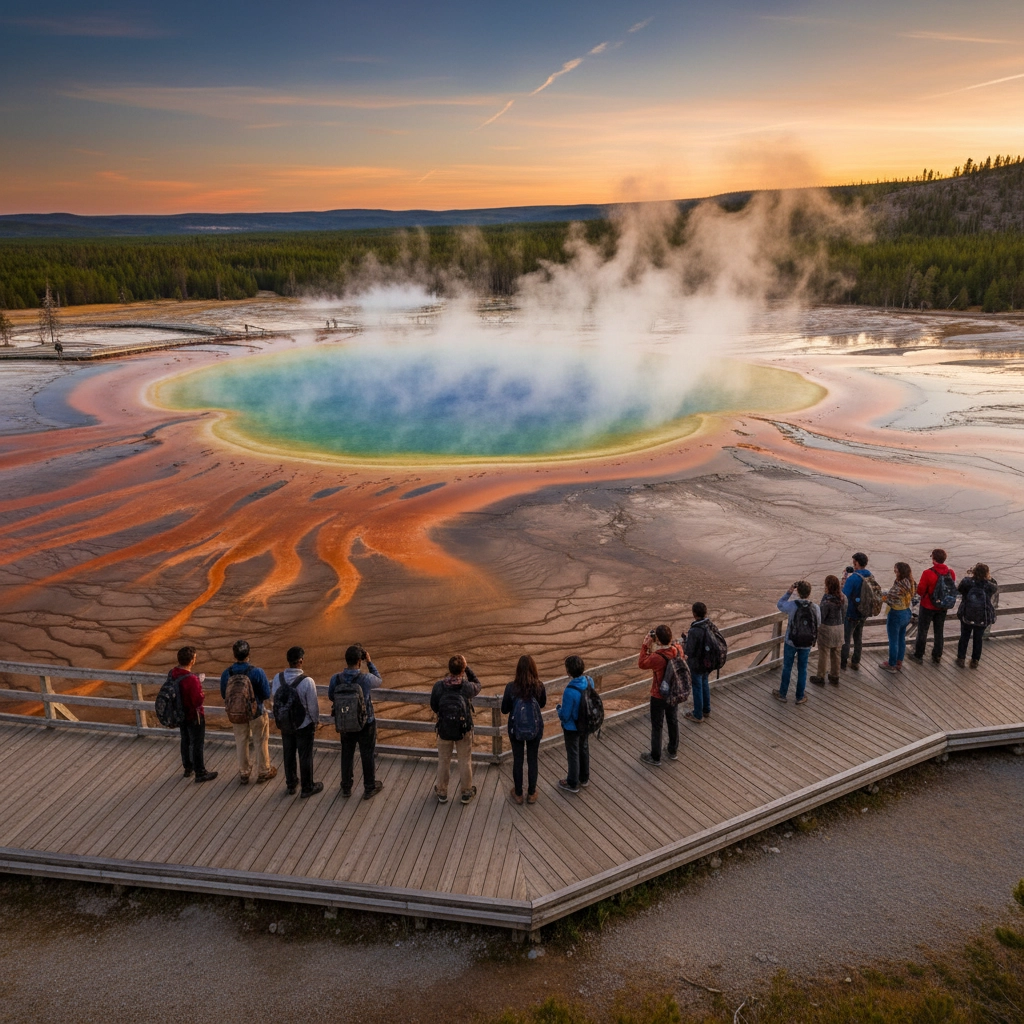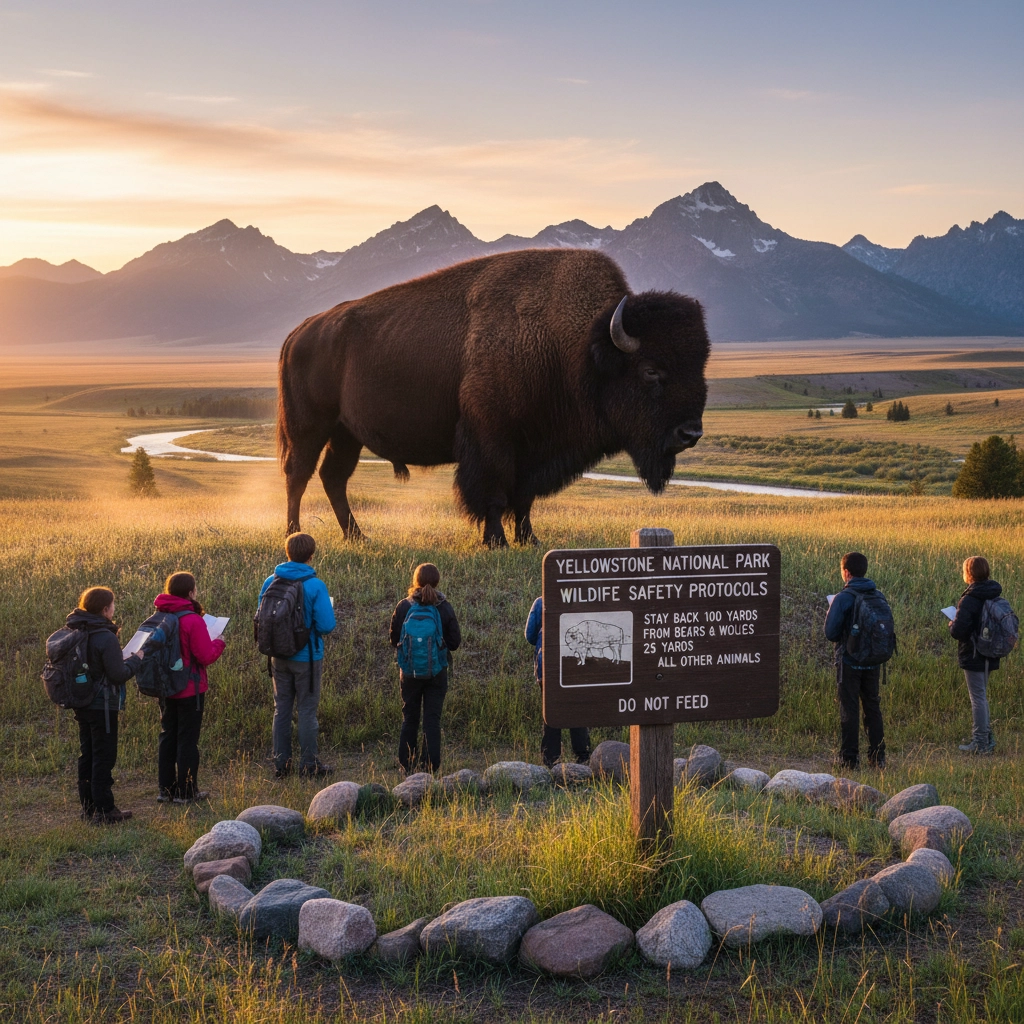The Ultimate Guide to Planning Student Trips to Yellowstone: Everything Teachers Need to Know
- Caleb Mullenix
- Oct 20
- 7 min read
Planning a successful student trip to Yellowstone National Park requires meticulous preparation, comprehensive understanding of available educational resources, and unwavering commitment to student safety. As America's first national park, Yellowstone offers unparalleled opportunities for hands-on learning in geology, wildlife biology, ecology, and cultural history. This guide provides teachers with the essential knowledge and step-by-step strategies needed to organize transformative educational experiences that align with curriculum standards while ensuring student safety and engagement.
Understanding Yellowstone's Educational Value
Yellowstone National Park serves as a living laboratory where students can observe geological processes, wildlife behavior, and ecosystem interactions firsthand. The park's 452 miles of roads connect diverse educational opportunities, from active geysers and hot springs to pristine wilderness areas supporting large mammal populations.
Establish clear learning objectives before beginning your planning process. Yellowstone supports curriculum standards in earth science, biology, environmental science, geography, and cultural studies. The park's thermal features demonstrate geological processes that typically require abstract thinking, while wildlife viewing opportunities allow students to observe animal behavior and ecological relationships in natural settings.

Create connections between park experiences and classroom learning by identifying specific curriculum standards your trip will address. The National Park Service provides curriculum materials specifically designed for different grade levels, including lesson plans that can be implemented before, during, and after your visit.
Professional Development: Preparing Yourself as an Educator
Begin your Yellowstone planning by participating in professional development opportunities offered through Yellowstone Forever. The organization provides STEAM Teacher Workshops that offer multi-day professional development with continuing education credits. These workshops combine hands-on fieldwork with curriculum design, focusing on STEAM education, Next Generation Science Standards (NGSS), and Indigenous perspectives.
Attend these workshops to gain confidence in leading student groups through complex educational experiences. The professional development includes lodging and meals, allowing you to experience the park from a student's perspective while learning from expert educators. This preparation proves invaluable when designing place-based learning experiences that integrate seamlessly into your broader curriculum.
Consider scheduling your professional development at least one year before your planned student trip. This timeline allows you to incorporate learned strategies into your classroom instruction, building student excitement and knowledge before the actual visit.
Planning Your Trip: Logistics and Timeline
Establish Your Timeline 12-18 Months in Advance
Begin planning your Yellowstone trip at least 12-18 months before your intended travel date. This extended timeline ensures availability of accommodations, educational programs, and transportation options during peak educational travel seasons.
Create a comprehensive planning checklist that includes:
Initial budget estimates and administrative approval
Educational program reservations with Yellowstone Forever
Accommodation bookings at park facilities or nearby locations
Transportation arrangements for both travel to the park and internal transportation
Permission forms and medical documentation collection
Pre-trip educational activities and curriculum integration
Determine Optimal Timing for Your Group
Consider your educational goals when selecting travel dates. Summer months provide full access to park facilities and programs but involve larger crowds and higher costs. Shoulder seasons offer fewer crowds and potentially lower accommodation costs but may limit access to certain areas due to weather conditions.
Yellowstone Forever's Lodging & Learning programs operate from December through February and May through October, providing 4-6 day guided learning experiences with lodging, transportation, and most meals included. These programs eliminate many logistical challenges while ensuring high-quality educational content.

Educational Programs and Curriculum Integration
Yellowstone Forever Group Programs
Collaborate with Yellowstone Forever to design custom itineraries tailored to your group's specific goals and interests. These programs offer hands-on science, hiking, and cultural learning opportunities available year-round, with expert field educators ensuring comprehensive understanding of the park's features.
The organization's small group format promotes deeper engagement with topics ranging from wildlife tracking to landscape studies. Programs operate from strategic locations including Lamar Buffalo Ranch and facilities in Gardiner, Montana, providing students with immersive experiences in different park ecosystems.
Age-Appropriate Program Selection
Select programs appropriate for your students' developmental levels. Yellowstone Forever offers residential curriculum-based programs designed specifically for 4th through 8th grade classes, focusing on natural and cultural history through 4-5 day experiences. These programs include structured activities, guided exploration, and opportunities for reflection and discussion.
For younger students (Pre-K through 2nd grade), utilize the park's 60-minute lesson plans that teach about symbols and main park features through engaging activities. These materials align with Common Core State Standards for English Language Arts and provide excellent pre-trip preparation.
Advanced students benefit from Field Seminars led by scientists, artists, and Indigenous knowledge keepers. These 1-6 day immersive learning experiences offer rigorous academic content perfect for high school and college students seeking deeper understanding of specialized topics.
Safety Protocols and Risk Management
Thermal Feature Safety
Emphasize the paramount importance of thermal feature safety in all pre-trip communications with students and parents. Yellowstone's thermal features present serious hazards, including unpredictable eruptions, unstable ground surfaces, and water temperatures exceeding 200 degrees Fahrenheit.
Establish and enforce strict behavioral expectations:
Students must remain on designated boardwalks and marked trails at all times
No running or horseplay near thermal features
Immediate compliance with all posted warning signs
Maintaining visual contact with supervising adults
Conduct thorough safety briefings before visiting each thermal area, reinforcing these expectations and explaining the scientific reasons behind safety protocols.
Wildlife Safety Procedures
Develop comprehensive wildlife safety protocols that address the park's large mammal populations, including bison, elk, bears, and wolves. Create specific distance requirements for different species and teach students to recognize animal behaviors that indicate stress or aggression.
Establish clear procedures for wildlife encounters:
Maintain minimum distances of 25 yards from bison and elk, 100 yards from bears and wolves
Never attempt to feed or approach any wild animals
Report all wildlife sightings to supervising adults immediately
Know evacuation procedures for different types of wildlife encounters

Supervision Requirements
Implement appropriate adult-to-student ratios that exceed standard field trip requirements. Yellowstone's diverse hazards require enhanced supervision, particularly for younger students. Consider the maturity level of your group when determining supervision needs, with younger students requiring closer monitoring.
Assign specific supervisory responsibilities to each adult chaperone, including designated areas of the group and specific safety protocols. Ensure all adults understand park regulations, emergency procedures, and location of first aid equipment.
Age-Appropriate Considerations
Elementary Students (Grades K-5)
Focus elementary student experiences on observable phenomena and hands-on learning opportunities. Utilize the park's dramatic visual features to teach basic concepts about geology, wildlife, and ecosystems. Emphasize safety through constant supervision and simplified safety rules.
Create structured activities that maintain student engagement while ensuring safety. Consider shorter hiking distances, frequent rest stops, and alternative indoor activities for inclement weather. Provide clear behavioral expectations and consistent enforcement of safety rules.
Middle School Students (Grades 6-8)
Engage middle school students through inquiry-based learning that connects park features to scientific concepts. Encourage hypothesis formation and testing through guided observation activities. Utilize the park's diverse ecosystems to teach ecological relationships and environmental science concepts.
Increase student responsibility gradually while maintaining appropriate supervision. Allow students to lead certain discussions or presentations about observed phenomena, building confidence and ownership of their learning experience.
High School Students (Grades 9-12)
Challenge high school students with complex scientific concepts and research-based activities. Utilize field seminars and advanced programming to explore specialized topics in greater depth. Encourage critical thinking about conservation, resource management, and human impacts on natural systems.
Provide opportunities for independent research projects and presentations. Consider partnerships with local researchers or park scientists to expose students to potential career paths in natural resource fields.
Booking and Accommodation Strategies
Secure Accommodations Early
Book accommodations immediately upon finalizing your travel dates. Both in-park and nearby accommodations fill quickly, particularly during peak educational travel seasons. Consider the advantages of staying within the park versus nearby gateway communities, weighing convenience against cost considerations.
Yellowstone Forever offers lodging at interior park locations including Canyon, Lake, and Mammoth Hot Springs for their Lodging & Learning programs. These locations provide convenient access to educational programming while eliminating daily commute times.
For groups requiring custom arrangements, campus lodging is available through Group Programs, offering cost-effective accommodation options designed specifically for educational groups.
Transportation Planning
Plan internal park transportation carefully, considering the significant distances between major attractions. The park's 452 miles of roads require substantial driving time, making efficient itinerary planning essential for maximizing educational opportunities.
Consider organizing your days by park regions to minimize long drives: North Yellowstone (Mammoth Hot Springs, Lamar Valley), Central Yellowstone (Grand Canyon of the Yellowstone, Yellowstone Lake), and West Yellowstone (Geyser Basins, Old Faithful). This regional approach reduces travel time while allowing deeper exploration of each area's unique features.
How Appleseed Expeditions Supports Your Success
Appleseed Expeditions specializes in creating seamless educational travel experiences that eliminate logistical stress while maximizing learning opportunities. Our partnership with Yellowstone Forever ensures your students receive expert-led programming tailored to your curriculum goals and student needs.
We handle all aspects of trip logistics, from transportation and accommodations to meal planning and emergency protocols. Our experienced team understands the unique requirements of educational travel and maintains the highest safety standards throughout your journey.

Our pre-trip support includes curriculum materials, safety training for chaperones, and detailed itinerary planning that balances structured learning with opportunities for wonder and exploration. We provide 24/7 support during your trip, ensuring immediate assistance for any challenges that may arise.
Consider partnering with Appleseed Expeditions to transform your Yellowstone planning from overwhelming logistics management into focused educational preparation. Our expertise allows you to concentrate on creating meaningful learning experiences while we handle the complex details of group travel.
Budget Planning and Financial Considerations
Develop comprehensive budgets that account for all trip expenses, including entrance fees, accommodations, meals, transportation, and educational programming costs. Consider purchasing annual park passes for groups planning multiple visits or extended stays.
Explore funding opportunities through grants, fundraising activities, and parent contributions. Many organizations provide grants specifically for educational travel, and early planning allows time to pursue these opportunities effectively.
Budget for contingency expenses, including weather-related delays, medical emergencies, and unexpected accommodation changes. Maintain emergency funds equal to approximately 10% of your total trip budget for unforeseen circumstances.
Ensuring Successful Educational Outcomes
Prepare students thoroughly before departure through pre-trip lessons using National Park Service curriculum materials. Students should complete activities that familiarize them with park features, safety requirements, and expected learning outcomes. This preparation creates excitement while establishing behavioral expectations and learning objectives.
Implement structured reflection activities during and after your trip to reinforce learning and assess educational outcomes. Consider journaling requirements, group discussions, and post-trip presentation projects that demonstrate student understanding and engagement.
Document your experience thoroughly for future trip planning and administrative reporting. Collect student feedback, evaluate program effectiveness, and maintain detailed records of successful strategies and areas for improvement.
Planning a successful student trip to Yellowstone requires dedication, careful preparation, and unwavering commitment to safety and educational excellence. By utilizing available resources, maintaining high safety standards, and partnering with experienced educational travel professionals, you can create transformative learning experiences that inspire students and enrich their understanding of our natural world. The investment in thorough planning ensures your students return home with increased scientific knowledge, environmental awareness, and lasting memories of one of America's most magnificent landscapes.



Comments